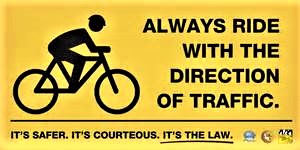
Bike Safely
As you work to build more bicycling in your daily routine, you should also be aware of safe bicycling and driving practices and incorporate these, as well. Acting as an alert, cautious, and responsible bicyclist (or motorist) will create a safer and more comfortable environment for all road users and will provide a positive example for others. Safety is a shared responsibility for all road users, including drivers and bicyclists. The following are some tips to improve road safety for everyone.
Safety tips for bicyclists
Always ride with traffic and follow the rules of the road. Forget what you might have heard in the past, you are better off riding with the flow of traffic, not against it. You are much more predictable and visible to motorists, especially at intersections and driveways. Ride in a straight line, not in and out of cars, and use hand signals when turning and stopping. Obey traffic signs, signals, and lane markings and yield to traffic when appropriate, including pedestrians.
Don’t ride on the sidewalk. Although you might think it’s a safer option, motorists are simply not looking for bicyclists on the sidewalk, especially those riding against traffic. So at every driveway and intersection, you are at much greater risk of being hit by a motorist than if you were riding on the road with traffic. Pedestrians will thank you for riding on the road as well.
Ride on the trail, paved shoulder, bike lane, or bike route. But, you still need to follow the rules of the road and watch out for your fellow travelers. Ride to the right, signal your turns, obey traffic signs and signals.
Be predictable and visible. Try not to be hesitant or do things that motorists and other travelers may not be expecting. Make sure everyone can see you and knows where you are and where you are going. If riding in the dark, use headlights, taillights and reflectors, and wear reflective materials and brightly colored clothing. Do not wear headphones or talk on a cell phone while bicycling.
Watch for stuff on the road or trail that might make you fall or swerve. Rocks, trash, storm grates, wet leaves, potholes, gravel, railroad tracks, and even wet pavement markings can all send you flying. Also watch for parked cars, doors opening, and cars pulling in and out of driveways.
Watch for turning traffic. Perhaps rather surprisingly, the crash data tells us that getting hit from behind is extremely unlikely. Most car/bike collisions happen at intersections and driveways when motorists or bicyclists are turning. So, at every intersection and driveway, keep a careful eye out for:
Motorists turning right in front of you-you may be going faster than they think.
Motorists turning left across your path-drivers are looking for gaps in traffic and may not be paying attention to anything other than other motor vehicles.
Safety tips for motorists
Watch for Bicyclists at all Times. Bicycles are vehicles and bicyclists may take the entire lane. Scan for bicyclists in traffic and give them the appropriate right-of-way. Children and novice riders can be unpredictable; expect the unexpected. Watch for bicyclists before opening car doors. Don’t drive distracted or after consuming alcohol or other drugs.
Drive the Speed and Avoid Aggressive Maneuvers. Obey speed limits and come to a complete stop at stop signs. Allow extra time for bicyclists to traverse intersections. Recognize hazards that bicyclists may face and give them space to maneuver.
Pass Bicyclists with Care. Treat bicyclists as you would a slow-moving car-don’t tailgate, and do wait until traffic conditions allow you to safely pass the bicyclist. Reduce speed when passing bicyclists and allow at least 3 ft of passing space. Check over your shoulder after passing a bicyclist before moving back. Don’t blast your horn in close proximity to bicyclists.

